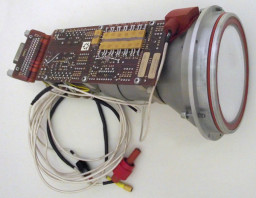The more recent Cathode Ray Tube (CRT) for the Company Pilot’s Display Units are supplied as a CRT Assembly incorporating the CRT within its mu-metal housing. The CRT has a deflection coil within the casing which magnetically deflects the beam; focussing is electrostatic. The final anode operates at a high voltage of 18kV or more and the focus voltage is in the range 3-5kV.
A range of fine grain phosphors are used on the screen and the inside face, on which the phosphor is deposited, is accurately aligned to the mounting flange of the tube to ensure it coincides with the optical module's image plane.
When the CRT Assembly is fitted with its Matching Card it forms a Tube Unit Assembly (TUA).
The latest raster/cursive CRTs have a blank or silvered area usually at the bottom of the screen where the beam is deflected for a beam current calibration test. This is found on F-16 C/D (which introduced the idea), LANTIRN and Typhoon.
4500 Series GEC Ferranti HUD: This TUA operates in a raster or cursive mode and uses a P43 phosphor.
C-17 HUD: The circular faceplate of this CRT is blanked top and bottom to match the shallow prism optics in the relay. A P43 phosphor is used and the HUD was planned to have growth to a raster display but this was not installed. This part number in the reference database is wrongly attributed to EFA.
F-5 HUD: This is a conventional TUA and is cursive mode only with a P1 phosphor
F16A/B HUD: It was during this programme that the TUA became a subcontract item. The cursive only TUA uses a P1 phosphor
F-16C/D HUD: A large circular screen with a test area and using a P1 phosphor The TUA operates in raster/cursive and combined modes.
Gulfstream HUD: A truncated CRT operating in cursive modes with a P43 phosphor
LANTIRN HUD: A truncated CRT operating in raster/cursive and combined modes with a P43 phosphor
Typhoon HUD: A truncated CRT operating in raster/cursive and combined modes with a high drive P53 phosphor




